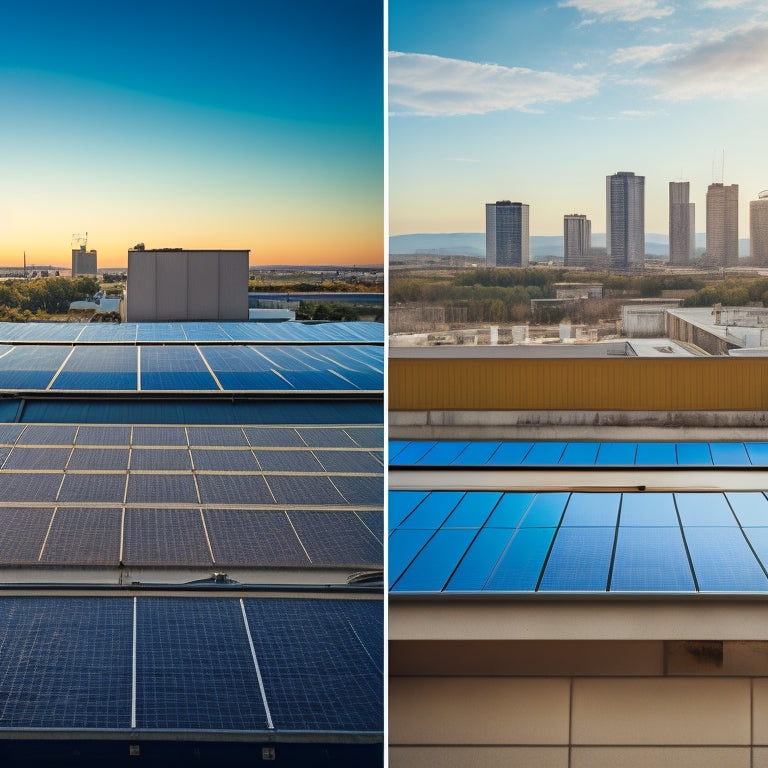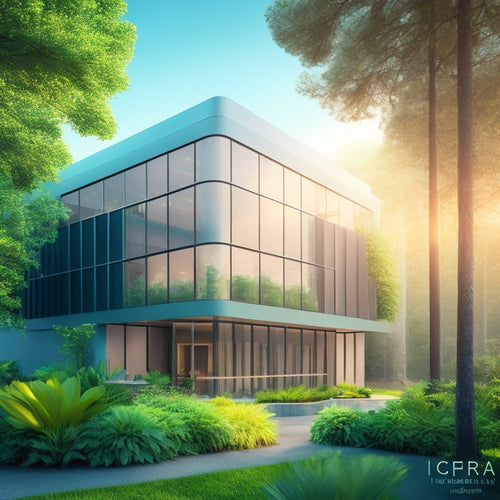
Commercial Panel Maintenance Cost Breakdown: 10 Key Factors
Share
When calculating the cost of commercial panel maintenance, you need to take into account at least 10 key factors. System size and complexity, maintenance frequency and scheduling, and regional labor and material costs are essential considerations. You'll also need to factor in panel cleaning and inspection, repair and replacement costs, and inverter maintenance and upgrades. Additionally, think about manufacturer warranty and support, on-site vs remote monitoring, and preventative maintenance tasks. Overlooking any of these factors can lead to inaccurate estimates and unexpected expenses. By examining each of these factors, you'll gain a more thorough understanding of the true cost of commercial panel maintenance.
Key Takeaways
• Labor costs vary by region, influenced by cost of living, labor laws, and tariffs, affecting commercial panel maintenance costs.
• Material costs, including import duties, taxes, and transportation costs, impact the overall cost of commercial panel maintenance.
• Regular maintenance tasks, such as cleaning and inspections, help minimize downtime and reduce costly repairs, ultimately saving on maintenance costs.
• Inverter maintenance, including redesign for optimization, is crucial to maximizing return on investment and reducing maintenance costs.
• Component replacement costs, including inverters and panels, add up quickly, emphasizing the need for proactive maintenance strategies to manage costs.
System Size and Complexity
Prioritizing system scalability and design optimization is crucial as you scale up your commercial panel system. The complexity of its architecture and the number of components involved directly impact maintenance costs, with larger systems typically requiring more frequent and specialized maintenance. This is because larger systems have more components to monitor, repair, and replace, leading to increased labor and material costs.
To mitigate these costs, prioritize system scalability and design optimization from the outset. By designing your system with scalability in mind, you can minimize the complexity and number of components, reducing maintenance costs over time. This involves selecting components with high reliability, minimizing interconnections, and optimizing system architecture to reduce points of failure.
Maintenance Frequency and Scheduling
Regular maintenance scheduling is crucial to minimizing downtime and extending the lifespan of your commercial panel system, and you should aim to strike a balance between proactive maintenance and reactive repairs. Effective maintenance frequency and scheduling can help prevent unexpected failures and reduce overall maintenance costs.
| Maintenance Frequency | Seasonal Scheduling | Calendar Planning |
| Quarterly | Align with seasonal changes (e.g., winter, summer) | Schedule maintenance during periods of lower energy demand |
| Bi-Annually | Consider weather patterns and potential environmental hazards | Prioritize maintenance during off-peak seasons to minimize disruptions |
| Annually | Coordinate with other facility maintenance schedules | Review and adjust maintenance schedules annually to ensure peak performance |
Panel Cleaning and Inspection
You'll next want to focus on panel cleaning and inspection, a critical aspect of commercial panel maintenance that can greatly impact energy output and overall system longevity.
Debris accumulation on your panels can lead to significant energy losses, making regular cleaning essential. You'll need to take into account the environmental impact of cleaning methods and products, selecting eco-friendly options that won't harm the surrounding ecosystem.
During inspections, look for signs of physical damage, corrosion, or wear that could compromise system performance. A thorough inspection will help identify potential issues before they become major problems, saving you time and money in the long run.
Repair and Replacement Costs
When evaluating the repair and replacement costs of your commercial panel, you'll need to take into account the panel failure rates. These rates can vary depending on factors like environmental conditions and quality of installation. For instance, a panel with a high failure rate will likely require more frequent component replacements, resulting in higher costs.
Panel Failure Rates
When calculating the total cost of commercial panel maintenance, it's important to take into account the likelihood of panel failure and the subsequent repair or replacement costs that will inevitably follow.
As you assess your panel's reliability, consider the impact of environmental stress, such as extreme temperatures, humidity, and UV exposure, which can cause components to degrade over time.
Additionally, human error during installation, operation, or maintenance can also contribute to panel failure. By understanding these factors, you can better anticipate and prepare for potential failures, reducing downtime and minimizing costly repairs.
Component Replacement Costs
Your commercial panel's component replacement costs can add up quickly, especially if you're dealing with frequent failures or complex repairs that require specialized labor and equipment.
You'll need to take into account the cost of replacement parts, which can be impacted by component obsolescence, making it challenging to find compatible replacements. Supply chain disruptions can also drive up costs, leading to longer lead times and increased expenses.
Additionally, the complexity of the repair may necessitate specialized tools and expertise, further increasing costs.
To effectively manage these costs, it's crucial to have a thorough maintenance strategy in place, including proactive monitoring, regular maintenance, and a robust inventory management system.
Inverter Maintenance and Upgrades
You'll need to budget for regular inverter maintenance, which involves inspecting and cleaning the units, updating firmware, and replacing worn-out parts, to guarantee peak performance and prevent unexpected downtime. This routine maintenance is essential to make sure your commercial solar panel system operates at its best level.
During maintenance, technicians will inspect the inverter's electrical connections, thermal sensors, and fans to identify any potential issues. They'll also perform firmware updates to keep your system up-to-date with the latest features and improvements.
In some cases, inverter redesign may be necessary to optimize performance or adapt to changes in your energy needs. By staying on top of inverter maintenance and upgrades, you'll minimize the risk of system failures and maximize your return on investment.
Energy Monitoring and Tracking
Accurate energy monitoring and tracking enable commercial solar panel system owners to pinpoint underperforming areas, optimize energy production, and make data-driven decisions to maximize their return on investment. You can leverage real-time analytics to identify areas of improvement, reducing energy losses and increasing overall system efficiency. Effective energy monitoring and tracking also facilitate data visualization, allowing you to easily interpret complex data and make informed decisions.
| Monitoring Aspect | Benefits | Cost |
| Real-time analytics | Identify underperforming areas, optimize energy production | $500 - $1,000 |
| Data visualization | Easily interpret complex data, make informed decisions | $300 - $800 |
| Performance benchmarking | Compare system performance to industry standards | $200 - $500 |
| Customizable alerts | Receive notifications for system anomalies, take prompt action | $100 - $300 |
Manufacturer Warranty and Support
Beyond energy monitoring and tracking, a commercial solar panel system's reliability hinges on the manufacturer's warranty and support, which can greatly impact maintenance costs and system uptime. You should carefully evaluate the warranty terms, including the length of coverage, scope of protection, and process for filing claims.
Look for manufacturers that offer warranty extensions or flexible warranty options to minimize maintenance costs. Additionally, assess the quality of support hotlines, online resources, and on-site technical support.
A responsive and knowledgeable support team can reduce downtime and help you resolve issues quickly, minimizing the impact on your business operations. By understanding the manufacturer's warranty and support, you can better plan for maintenance costs and minimize system downtime.
On-Site Vs Remote Monitoring
Proactive monitoring is essential to identifying potential issues before they escalate, and the choice between on-site and remote monitoring greatly impacts the cost and effectiveness of your commercial solar panel maintenance strategy.
As you weigh your options, consider the trade-offs. On-site monitoring provides immediate, hands-on troubleshooting, but it can be costly and labor-intensive.
Remote monitoring, on the other hand, offers real-time data and alerts, enabling you to respond quickly to issues, often at a lower cost. However, you'll need to guarantee robust data security measures to protect sensitive information.
Prioritize monitoring uptime to minimize downtime and maximize energy production. By choosing the right approach, you can optimize your maintenance strategy and minimize costs. Consider your specific needs and budget to make an informed decision.
Preventative Maintenance Tasks
Regularly performing preventative maintenance tasks, such as inspecting and cleaning panels, tightening loose connections, and verifying inverter functionality, can help you identify and address potential issues before they cause system downtime.
By incorporating predictive analytics into your maintenance routine, you can proactively schedule tasks and reduce the likelihood of unexpected failures. This proactive approach allows you to take control of your system's performance and minimize costly repairs.
By staying on top of maintenance, you can guarantee peak energy production and maximize your return on investment.
Regional Labor and Material Costs
When evaluating the cost of commercial panel maintenance, you'll need to factor in regional labor and material costs, which can vary considerably depending on your location and the specific requirements of your system. Labor costs, for instance, can vary greatly depending on the region's cost of living, labor laws, and local tariffs.
Material costs, on the other hand, can be influenced by import duties, taxes, and transportation costs. You should also consider local building codes, permits, and regulatory requirements that may impact your maintenance costs.
To get an accurate estimate, research local labor rates, material prices, and applicable taxes. This will help you create a more realistic budget and make sure you're prepared for any regional cost variations.
Frequently Asked Questions
What Is the Ideal Maintenance Schedule for a Commercial Solar Panel System?
You'll want to schedule seasonal checkups every 6-12 months to guarantee peak performance, and consider investing in extended warranties to mitigate repair costs, making sure your commercial solar panel system operates efficiently and effectively.
How Often Should I Inspect My Commercial Solar Panel System?
'Did you know 22% of solar panels are underperforming due to lack of maintenance? You should inspect your commercial solar panel system every 6-12 months, considering system age and weather conditions, to guarantee peak energy production and detect potential issues early.'
Can I Perform Maintenance Tasks Myself or Do I Need a Professional?
You can attempt DIY maintenance, but be mindful of DIY risks, like voiding warranties or causing electrical shocks. Alternatively, hiring a professional guarantees expert care, minimizing risks and maximizing Professional Benefits like optimized energy output and extended system lifespan.
What Is the Average Cost of Replacing a Commercial Solar Panel Inverter?
"An ounce of prevention is worth a pound of cure." You'll want to know that the average cost of replacing a commercial solar panel inverter ranges from $5,000 to $20,000, depending on inverter reliability and your replacement timeline, which can greatly impact your bottom line.
Are There Any Local or National Incentives for Commercial Solar Panel Maintenance?
You can tap into local and national incentives for commercial solar panel maintenance, such as tax credits and government rebates, which can greatly offset your maintenance costs, increasing your ROI and reducing your carbon footprint.
Related Posts
-

Sustainable Scrubbing: Top Bathroom Solutions for Earth-Conscious Homes
You're taking an important step towards creating a more sustainable home by switching to eco-friendly bathroom cleani...
-

Transform Your Outdoor Space With Recycled Plastic Lumber
By incorporating recycled plastic lumber into your outdoor design, you're not just building a deck or installing a fe...
-

7 Top HEPA Filters for Green Building Projects
You need a reliable HEPA filter for your green building project that aligns with your sustainable goals and guarantee...


